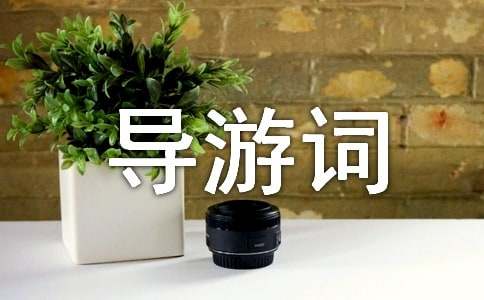刘公岛英文导游词
导语:刘公岛位于山东半岛最东端的威海湾内,人文景观丰富独特,既有上溯千年的'战国遗址、汉代刘公刘母的美丽传说,又有清朝北洋海军提督署、水师学堂、古炮台等甲午战争遗址,还有众多英租时期遗留下来的欧式建筑,素有“东隅屏藩”和“不沉的战舰”之称。下面由小编为大家整理的刘公岛英文导游词,欢迎大家阅读与借鉴!

Ladies and gentlemen,
Welcome to Weihai. I am very pleased to be at your service as a tour guide today.
Situated on the east end of Shandong Peninsula, east China, Weihai is a
beautiful city. Here you will find yourself in a picture of green mountains and blue sea, and it is pleased to your eyes and heart to see so many trees, flowers, and new buildings everywhere in the city. Among the numerous scenic spots here, Liugongdao Island attracts thousands of tourists every year with its unique charm. That is our destination today.
Located at the Weihai Bay, Liugongdao Island is 2.1 sea miles to the city, a distance that takes 20 minutes by ferry. Everybody, please board the ship and let’s go for a look.
Now our ship is departing the ferry slowly. Since we have 20 minutes to get there, I’ll make use of the time to tell you something about the history of Liugongdao Island.
According to archeological studies, the inhabitation on the island traces back as early as to the Warring States Period (403-221bc) and their remains can be found on the southeast of the island. During the Guongxu period in the Qing
Dynasty, when the government began to set up the first navy, Liugongdao island was take as the navy base, and lot of facilities had been built. In the spring of 1895, after the Sino-Japanese war of 1894-1895 ended, the island was under the occupation of the Japanese army for three years. In 1898, the United Kingdom gained the lease of Weihai by force, and Liugongdao was under the occupation of UK for 32 years until 1930. In 1948, the troops led by Jiang Keshi occupied the island, and soon the island was liberated by the People’s Liberation Army.
Since new China was founded in 1949, Liugongdao Island has been well
preserved. The whole island is densely covered with woods, most of which are black pines. It was ratified as a national forestry park in 1985, and in 1999 the island was nominated as a “national level tourist resort for high standard service”. Once being the base of the Northern Navy as well as the battle field of the war, there are 28 historical sites in the island including the Northern Navy
Headquarters, Dragon King Temple, Ding Ruchang’s Residence, the Navy school, fort and dock, all of which are designated “national major preservation unit of cultural relics”.
Well, that’s the brief history of the island, and we can see that it is not only a beautiful scenic sport, but also a very important witness of history.
Ladies and gentleman, here we are on the island.
Now, in front of us is the most magnificent building on the island which is called “The Northern Navy Headquarters ”.
The inscriptions on the archway in front of the building which mean “China museum of the Sino-Japanese war of 1894-1895” were written by president Jiang Zemin. This building was built in 1887 with a land area of more than
10,000 square meters. The Headquarters consist of three halls, first let’s enter the front hall.
Here is a big “sand map” of the over all disposition of the North Navy in 1894. From this map you could realize that the island has really a very important strategic position, because it exactly guards the mouth of Weihai Bay. At that time there were six forts on this island which guarded the bay together with
those on the shores, solid defenses were set up with torpedoes, logs and iron chains, which shouldn’t be broken through by the invaders. But we know that the Japanese Navy landed from Rongcheng, and attacked Liugongdao from the land. Apart from this consideration, the government at that time was corrupt and incompetent. They adopted the conservative strategy, and thus led the fall of Liugongdao Island.
Well, ladies and gentlemen, you have learned the position of the island from the sand map. Please follow me into the next hall and have a visit of the waxworks. The wax figures shown here were the high-ranking commanders who were in a military meeting before the battle. Some of them proposed to launch an attack, some of them were in favor of defending. In the middle sat Ding Ruchang, the general of the Northern Navy. He committed suicide after the fall of Liugongdao Island.
Ok, everyone, let’s move on to the back hall. Yes, these are the model warships of the Northern Navy. They were all made according to real photos or data from records. Yes, an illustration of the battle that happened in the Yellow Sea, on September 17th, 1894. That battle lasted about five hours and five of the ten warships of the Northern Navy were destroyed. It was after this battle that the Qing Government adopted the conservation policy. They didn’t allow the
warships to go out of Weihai Bay, so the sea was controlled by Japanese Navy. And this led the ruin of the whole Northern Navy.
Ok, everybody. I think you’ve learned a lot about the Northern Navy and its headquarters, pay attention that cameras are forbidden here in the hall, you could take some pictures outside. I will give you a 10-minute break. We’ll get together at 10:45 just in front of the gate of the headquarters, OK.
【刘公岛英文导游词】相关文章:
威海刘公岛导游词10-17
刘公岛导游词「精选」10-25
威海刘公岛景区导游词-导游词范文12-28
海南旅游英文导游词11-04
北戴河英文专业导游词08-18
开平碉楼导游词(英文)10-30
故宫英文导游词精选10-29
西双版纳英文导游词10-29
巴黎导游词英文3篇01-21
黄山英文导游词5篇12-29